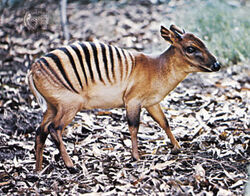| Zebra Duiker | |
|---|---|
 | |
| Scientific Classification | |
| Kingdom | Animalia |
| Conservation Status | |
 Vulnerable | |
The zebra duiker (Cephalophus zebra) is a small antelope found in Ivory Coast, Guinea, Sierra Leone and Liberia. It has also been recently discovered in south east Guinea.
Physical Characteristics[]
Head and body length: 85-90 cm Shoulder height: 40-50 cm Tail length: 15 cm Adult weight: 15-23 kg
The zebra duiker's light gold or reddish-brown body is strikingly marked from the shoulders to the rump with 12-16 black (or dark brown) transverse stripes. The striping pattern (number of stripes, degree of tapering, and arrangement) is unique to each individual. The shoulders and lower legs are darker than the rest of the body, and blackish bands encircle the upper legs (both front and rear). The undersides are pale. The tail is rufous and lacks stripes. The face is an overall deep chestnut brown color; there are no distinctive markings, but the muzzle is black and the lower jaw whitish. The horns are short, smooth, sharp cones in both males (4-5 cm) and females (up to 2-3 cm).
Reproduction and Development[]
Gestation period: 221-229 days. Litter size: One. Weaning: Around 95 days. Sexual maturity: Approximately two years. Life span: 11-13 years in captivity.
Zebra duikers breed year-round, conceiving shortly after giving birth. Mothers hide their babies for the first 2-3 weeks after birth, leaving the infant tucked away in dense vegetation and visiting it, on average, four times daily for nursing. Young zebra duikers have a bluish cast to their coat and very closely-spaced stripes. Beginning at two months of age, the coat gradually turns golden; adult coloration is reached by 7-9 months.
Ecology and Behavior[]
The zebra duiker is a diurnal species, but is shy and rarely seen in the wild. The normal social unit appears to be a breeding pair; the pair bond is reinforced with mutual rubbing, licking, and scent-marking. This species is thought to be territorial, and (based on heavy scars in many individuals) appears to fight quite vigorously. Although generally quiet, both sexes my make throaty grunting sounds during courtship.
Family group: Breeding pairs or solitary. Diet: Mostly fruits and seeds, also leaves and sometimes animal matter. Main Predators: Leopard.
Habitat and Distribution[]
Zebra duikers are found only in closed-canopy rainforests in West Africa. They are very sensitive to forest disturbance, and their range - centered around Liberia - continues to decline. The approximate range is depicted in the map below.
Conservation Status[]
IUCN Red List: Vulnerable (2012). CITES Listing: Appendix II (2012). Threats: Hunting and habitat loss.
The zebra duiker is highly dependent on mature rainforest, and is thus one of the first species to disappear with logging. Recent population estimates suggest that only 15,000 individuals may survive in the wild.




